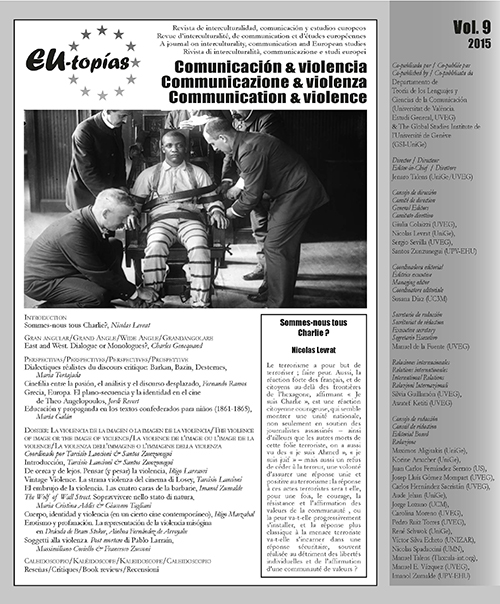The Wolf of Wall Street. Sopravvivere nello stato di natura
DOI:
https://doi.org/10.7203/eutopias.0.18752Keywords:
Capitalism, cartography, control, Wall Street, Martin Scorsese, subjectivation, subjection Abstract
Abstract
Contemporary cinema has widely inquired the regime of violence deployed by financial capitalism and The Wolf of Wall Street (2013) by Martin Scorsese elaborates an appropriate representation of power relationships arisen from market globalization and the dematerialization of goods. The narration of a return to a savage and primordial dimension of violence thus stages a state of nature which is foreign to the laws ruling social behavior and nevertheless becomes the ground for a new contractuality opposed to the existing state of right. In turn, this thematic dimension seems to be constantly doubled by an enunciational level, since it is the image itself which uses violence against the spectatorial gaze, imposing the main character’s unique point of view, which seems to expunge any form of otherness and difference. This paper aims at proposing a reflexion through images about the forms of subjectivation specific of the animal competition transposed to the virtual world of financial trade, intertwining the theory in action inside the film with Aesthetics and Critical Theory positions.
 Downloads
Downloads
 References
References
Arendt, Hannah (1996), Sulla violenza, Parma: Guanda. — (1999), Tra passato e futuro, Milano: Garzanti.
Benjamin, Walter (2011), Piccola storia della fotografia, Milano: Skirà.
Benveniste, Emile (1971), Problemi di linguistica generale, Milano: Il saggiatore.
Brecht, Bertolt (1973), «Il processo dell’Opera da tre soldi», Scritti sulla letteratura e sull’arte, Torino: Einaudi.
Calabrese, Omar (2012), La macchina della pittura, Firenze: La Casa Usher.
Casetti, Francesco (1986), Dentro lo sguardo. Il cinema e il suo spettatore, Milano: Bompiani.
Damisch, Hubert (1987), L’origine della prospettiva, Napoli: Guida.
Deleuze, Gilles (1984), Cinema 1. L’immagine-movimento, Milano: Ubulibri.
— (1990), «Post-scriptum sur les sociétés de contrôle», Pourparlers (1972-1990), Paris: Minuit, pp. 240-247.
Deleuze, Gilles & Guattari, Fèlix (1975), L’Anti-Edipo. Capitalismo e schizofrenia, Torino: Einaudi.
— (1980), Millepiani. Capitalismo e schizofrenia, Roma: Castelvecchi.
Dostaler, Gilles & maris, Bernard (2009), Capitalismo e pulsione di morte, Roma: La Lepre.
Farinelli, Franco (2004), Geografia, Torino: Einaudi.
— (2009), La crisi della ragione cartografica, Torino: Einaudi.
Foucault, Michel (1976), La volontà di sapere. Storia della sessualità 1, Milano: Feltrinelli.
— (1984), L’uso dei piaceri. Storia della sessualità 2, Milano: Feltrinelli.
Gentile, Emilio (2001), Le religioni della politica. Tra democrazia e totalitarismi, Roma-Bari: Laterza.
Gentili, Dario, Ponzi, Mario & stimilli, Elettra (ed.) (2014), Il culto del capitale. Walter Benjamin: capitalismo e religione, Macerata: Quodlibet.
Grande, Maurizio (2003), Il cinema in profondità di campo, Roma: Bulzoni.
Hadot, Pierre (2005), Esercizi spirituali e filosofia antica, Torino: Einaudi.
Lancioni, Tarcisio (2012), «Apparati di cattura. Per una semiotica della cultura», E/C [www.ec-aiss.it].
Marin, Louis (1973), Utopiques. Jeux d’espaces, Paris: Minuit.
Piketty, Thomas (2014), Il capitale nel XXI secolo, Milano: Bompiani.
Polacci, Francesca (2012), Sui collages di Picasso, Bologna: I Mulino.
Recalcati, Massimo (2012), Jacques Lacan. Desiderio, godimento, soggettivazione, Milano: Rafaello Cortina.
Downloads
Published
How to Cite
-
Abstract188
-
PDF 79
Issue
Section
License
![]()
The authors conserve the copyright. All content published in EU-topías. Journal of interculturality, Communication, and European Studies are subject to the license Creative Commons Attribution-NonCommercial-ShareAlike 4.0 license. The full text of the license can be found at <http://creativecommons.org/licenses/by-nc-sa/4.0>
They may be copied, used, disseminated, transmitted and publicly displayed, provided that:
- The authorship and original source of the publication is cited (journal, publisher and URL of the work).
- They are not used for commercial purposes.
- The existence and specifications of this license of use are mentioned.
It is the responsibility of the authors to obtain the necessary permissions for images that are subject to copyright.



